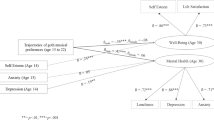Abstract
The psychological impact and meaning of rock music for adolescents needs to be addressed as a joint function of the type of music and the social context in which it is listened. Young adolescents in this study carried pagers for one week and reported their affect, arousal, and psychological involvement in their activities, including music listening, when signaled at random times. Regression analyses indicate that social context has its greatest impact on soft rock where subjective states are dramatically higher when this music is listened to with friends, as opposed to alone. This suggests that intimate companionship transforms the themes of longing and sadness characteristic of this music into a more positive and binding experience. Subjective states experienced listening to this music are also high when listening occurs in the bedroom, a finding that indicates a consistency between the music's themes and the use of the bedroom as a place for contemplation and reflection. Top 40 and hard rock/heavy metal music are experienced positively across a variety of social contexts, suggesting that their energy and collective message allows teens to experience mastery and power over their environment, even in contexts that are ordinarily lonely and alien. The one exception is when hard rock/heavy metal is listened to in the presence of family members, a situation that creates very negative subjective states. This is undoubtedly due to the dissonance of this music's themes with parental values.
Similar content being viewed by others
References
Brittain, C. V. (1963). Adolescent choices and parent-peer cross pressures.Am. Sociol. Rev. 28: 385–391.
Csikszentmihalyi, M. and Larson, R. (1987). Validity and reliability of the experience-sampling method.J. Nerv. Mental Dis. 175: 526–536.
Frith, S. (1978). Youth culture/youth cults: A decade of rock music consumption. In Gillette, C., and Frith, S. (eds.),Rock File 5. Panther, London.
Frith, S. (1983).Sound Effects: Youth, Leisure, and Rock and Roll. Constable, London.
Hanushek, E. A., and Jackson, J. E. (1977).Statistical Methods for Social Scientists. Academic Press, Orlando, FL.
Kandel, D., and Lesser, G. S. (1969). Parent-adolescent relationships and adolescent independence in the United States and Denmark.J. Marriage Family 31: 348–358.
Kaplan, L. J. (1984).Adolescence: The Farewell to Childhood. Simon & Schuster, New York.
Krippendorf, K. (1980).Content Analysis: An Introduction to Its Methodology. Sage, Beverly Hills, CA.
Kubey, R., and Larson, R. (1990). The use and experience of the new video media among children and young adolescents.Commun. Res. 17: 107–130.
Larson, R. (1989a). Beeping children and adolescents: A method for studying time use and daily experience.J. Youth Adolesc. 18: 511–530.
Larson, R. (1989b). The factor structure of moods and emotions in a sample of young adolescents. Unpublished manuscript, University of Illinois at Urbana-Champaign.
Larson, R. (1990). The solitary side of life: An examination of the time people spend alone from childhood to old age.Develop. Rev. 10: 155–185.
Larson, R., and Csikszentmihalyi, M. (1983). The experience sampling method. In Reis, H. T. (ed.),Naturalistic Approaches to Studying Social Interaction: New Directions for Methodology of Social and Behavioral Science, No. 15. Jossey-Bass, San Francisco.
Larson, R., and Kubey, R. (1983). Television and music: Contrasting media in adolescent life.Youth Society 15: 13–31.
Larson, R., Kubey, R., and Colletti, J. (1989). Changing channels: Early adolescent media choices and shifting investments in family and friends.J. Youth Adolesc. 18: 583–600.
Lyle, J., and Hoffman, H. R. (1972). Children's use of television and other media. In Rubinstein, E., Comstock, G., and Murray, J. (eds.),Television and Social Behavior, Volume 4: Television in Day-to-Day Life: Patterns of Use. U.S. Government Printing Office, Washington, D.C.
Murdock, G., and Phelps, G. (1973).Mass Media and the Secondary School. MacMillan, London.
Parke, R. D., and Sawin, D. B. (1979). Children's privacy in the home: Developmental, ecological, and child rearing determinants.Environ. Behav. 11: 87–104.
Roe, K. (1985). Swedish youth and music: Listening patterns and motivations.Communi. Res. 12: 353–362.
Smothers, J. (1961). The public and private meanings and uses of popular music for American Adolescents. Unpublished Ph.D. dissertation, University of Chicago.
Tanner, J. (1981). Pop music and peer groups: A study of Canadian high school students' reactions to pop music.Can. Rev. Sociol. Anthropol. 18: 1–13.
Wright, E. O. (1985).Classes. Verso, London.
Author information
Authors and Affiliations
Additional information
This research was carried out at Michael Reese Hospital in Chicago with a grant to Reed Larson from the National Institute of Mental Health (No. MH38324).
He received his M.A. from University of Windsor. He is in the final stages of completing a Ph.D. dissertation investigating the role the news media play in contributing to selected social and political attitudes toward AIDS.
He received Ph.D. from the Committee on Human Development, University of Chicago. His research focuses on daily experience associated with health and psychopathology in adolescence and across the life span.
Rights and permissions
About this article
Cite this article
Thompson, R.L., Larson, R. Social context and the subjective experience of different types of rock music. J Youth Adolescence 24, 731–744 (1995). https://doi.org/10.1007/BF01536954
Received:
Accepted:
Issue Date:
DOI: https://doi.org/10.1007/BF01536954




